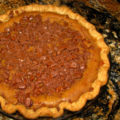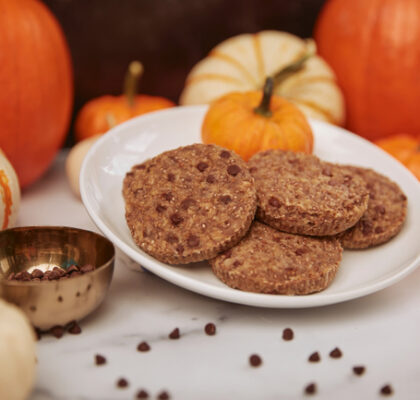
I have upped the nutritional content by using barley instead of Arborio rice for this comforting risotto. You won’t lose any of the creaminess and you’ll have a delicious whole grain recipe to add to your repertoire.
Although risotto should be served immediately, there are several components of the dish – such as frying the sage leaves, roasting the squash and chopping the onions – that can be prepared in advance so you don’t have to spend too long in the kitchen once your guests arrive.
Serve this as a first course, as a side with roasted or grilled meat or on its own as a vegetarian entrée.
Butternut Squash Barley Risotto with Fried Sage Leaves
1.5-2lbs butternut squash, peeled, seeded and diced
1 Tbs. extra virgin olive oil (for roasting squash)
Kosher salt
Freshly ground black pepper
6 C. low sodium chicken broth
3 Tbs. unsalted butter, divided
1 medium onion or 4 shallots, chopped
½ C. dry white wine
1 ½ C. pearled barley
½ C. freshly grated Parmesan
A dash of grated nutmeg
16 sage leaves, washed and dried (garnish)
1. Melt 2 Tbs. butter in a small sauté pan over medium-high heat. Add the sage leaves to the pan and cook until slightly crisp. Remove leaves with a slotted spoon or spatula and drain on a paper towel. The sage leaves can be fried several hours in advance.
2. Preheat oven to 400 degrees. Toss diced squash with olive oil, salt and pepper and spread in a roasting or sheet pan. Roast squash for 15 minutes, toss, and roast for another 10-15 minutes or until squash is tender and golden. Squash can be roasted up to 2 days in advance.
3. Heat broth in a small covered saucepan until simmering. Cover and keep broth at a slight simmer over low heat.
4. Heat remaining 1 Tbs. butter in a Dutch oven or heavy pot over medium heat. Once melted, add the onion (or shallots) and cook until soft and translucent, about 5-8 minutes. Add the barley to the pot and coat the grains with the butter-onion mixture until slightly translucent (this will prevent the barley from absorbing the liquid too quickly and makes the risotto more tender). Add the wine and cook until absorbed, about 2 minutes. Add about ½ C. simmering broth to the barley and cook, stirring frequently, until the stock is absorbed. Continue adding the broth, ½ C. at a time, and stir constantly. Let each addition of broth be absorbed before adding the next. Cook until the barley is creamy but still al dente, about 20 minutes total. (You may have leftover broth.)
5. Remove risotto from heat and add the squash, Parmesan and a dash of fresh grated nutmeg. Stir until well combined. Add salt and pepper to taste. Garnish each serving with 2 fried sage leaves and serve immediately.
Makes 8 servings as a side or first course (serves 4 as an entrée)
· By using a good technique to make risotto you can achieve the creaminess without the addition of any cream. If you feel that you risotto needs a little more creaminess add 1-2 Tbs. of butter at after you stir in the squash and parmesan.
· If you don’t want to bother with peeling and dicing the squash you can simply split it in half lengthwise, seed it, and roast it (cut side down) on a sheet pan sprayed with non-stick spray. Roast until tender, scoop out the flesh and add it at the end of the recipe when you would add the roasted cubes.
· Some variations on this recipe: You can add pancetta to the risotto (dice it and cook it with the onions before you add the barley); add chopped sage or ground cumin for even more flavor.
· Don’t plan on making any extra for leftovers – I have yet to find a technique that keeps the creaminess after reheating it.



























I love using barley, it has a more nutty and chewier texture. I enjoyed this recipe.
Love your site!
______________________________
Unlimited Public Records Searches!
I am going to try this recipe, it looks wonderful.
But, as to the “no leftovers” comment, I attended a cooking class in NYC recently, and the chef uses left-over rissoto ( all types) to make “risotto-balls”. She simply rolls the cooled left over risotto into small balls, and places on a cookie sheet… refrig. Then pop into the oven and bake and she uses them for h’or deuvres at another class. ( she serves a little something as we come in to tide us over for the meal at the end of the class)
Some people fry them, but she bakes them.
I found this one online:
Risotto Balls
“My mom would fry these in olive oil until golden and drain well and serve with fresh lemon squeezed over them,” Norma J. Ryan says. “For appetizers I often make them smaller in size and I also spray them with olive oil and bake them in the oven to avoid the excess oil of frying.” This recipe is not PG tested.
* 2 cups cooked risotto
* 1 egg
* About 1/4 cup grated romano cheese
* About 1/2 cup seasoned bread crumbs
* Olive oil cooking spray
Mix ingredients so they hold together. Take a spoon full of risotto, about the size of a golf ball, and shape it into an oval ball. Spray with oil and bake at 350 to 375 degrees for about 15 to 20 minutes, until golden brown. Top with freshly squeezed lemon juice.
Read more: http://www.post-gazette.com/pg/05279/583344-107.stm#ixzz0TMdqysMx
Amy – I love the ideas of risotto balls as an appetizer. Thanks for sharing!
Pingback: Super-super Whole Grains {nutrition tips} « Hip Mommies